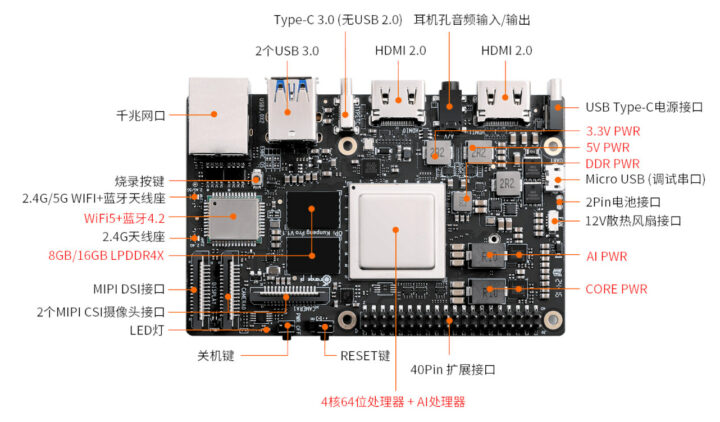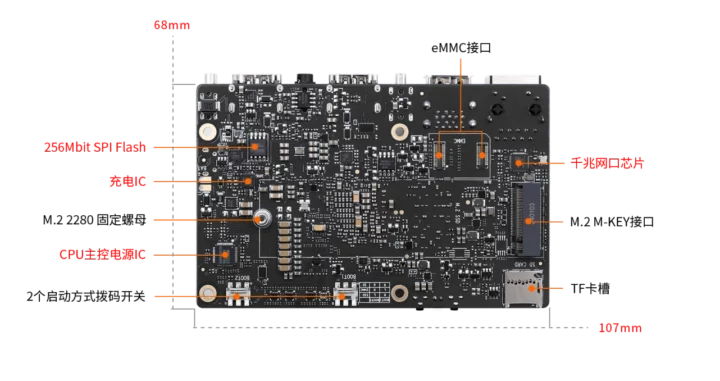Orange Pi KunPeng Pro is a single board computer powered by an unnamed KunPeng quad-core processor from Huawei that features an 8 TOPS NPU for AI workloads.
It’s not the first time Orange Pi has launched an SBC based on a Huawei SoC, as the company introduced the Orange Pi AIPro last year with another unnamed Huawei Ascend SoC with a 20 TOPS NPU. The new Orange Pi KunPeng Pro board has basically the same layout as the AIPro model, but with lower specs overall, although it still comes with 8GB or 16GB LPDDR4x memory.
 Orange Pi KunPeng Pro specifications:
Orange Pi KunPeng Pro specifications:
- SoC – Unnamed Huawei Kunpeng quad-core 64-bit SoC with unnamed GPU, 8 TOPS AI accelerator
- System Memory – 8GB or 16GB LPDDR4X
- Storage
- 32MB SPI flash
- connector for 32GB, 64GB, 128GB, or 256GB eMMC flash module
- MicroSD card slot
- M.2 2280 socket for SATA/NVMe drive
- Video Output
- 2x HDMI 2.0 ports up to 4Kp60
- 2-lane MIPI DSI via FPC connector
- Camera Interfaces – 2x MIPI CSI connectors
- Audio – 3.5mm audio jack, digital audio via HDMI
- Networking
- Gigabit Ethernet RJ45 port
- WiFi 5 and Bluetooth 4.2
- USB
- 2x USB 3.0 host ports
- 1x USB 3.0 Type-C host port
- Expansion – 40-pin GPIO header
- Misc
- Power key, Reset key, Flash key
- Boot mode selection DIP switch
- Fan connector
- Power Supply
- 20V (65W) via USB Type-C port
- 2-pin connector for battery
- Plenty of regulators
- Dimensions – 107 x 68 mm
- Weight – Around 82 grams
 While the AIPro would support openEuler or Ubuntu, the new Orange Pi Kunpeng Pro is only officially supported by openEuler. You’ll find the OS image along with documentation in Chinese on the Orange Pi CN website, since the board is not listed on the English website and never will be.
While the AIPro would support openEuler or Ubuntu, the new Orange Pi Kunpeng Pro is only officially supported by openEuler. You’ll find the OS image along with documentation in Chinese on the Orange Pi CN website, since the board is not listed on the English website and never will be.
Orange Pi removed all markings from photos of the board and Huawei does not want to disclose what architecture and GPU the chip is using to prevent or at least delay further US sanctions. But if we look at the documentation, we’ll find an image of the board and accessories that reads “Hilicon Hi1910” on the SoC.
It’s very hard to find any details about the HiSilicon Hi1910, but one of the device tree files for the Huawei Atlas 200 AI module is named “hi1910-asic-1004.dts”. What’s odd is that the Atlas 200 AI module delivers 22 TOPS of AI performance, so maybe it’s a cost-down version.
Technically Unsure purchased a sample for a review video last month, and the Orange Pi Kunpeng Pro shows up as Orange Pi Ai Pro (so it’s using the same image as the older board) and the OpenEuler 22.03 OS runs Linux 5.10.10+. GPU acceleration is not enabled (llvmpipe), and the CPU is shown as “0x00″…
Most people who are not based in China should stay away from this specific board, and Orange Pi will never officially sell it outside of China, but it’s still available on Aliexpress for $172.62 and up for people wanting to experiment.
Thanks to Radoslaw and ValdikSS for the tip.

Jean-Luc started CNX Software in 2010 as a part-time endeavor, before quitting his job as a software engineering manager, and starting to write daily news, and reviews full time later in 2011.
Support CNX Software! Donate via cryptocurrencies, become a Patron on Patreon, or purchase goods on Amazon or Aliexpress




